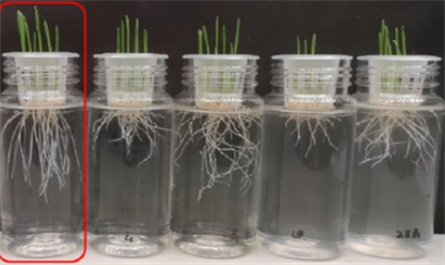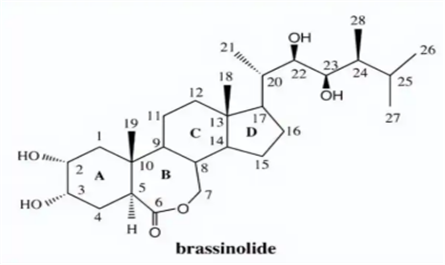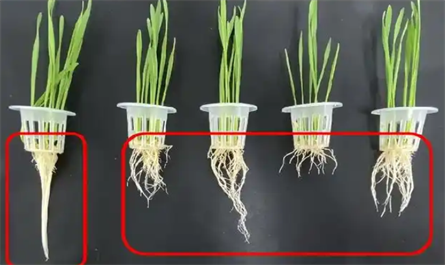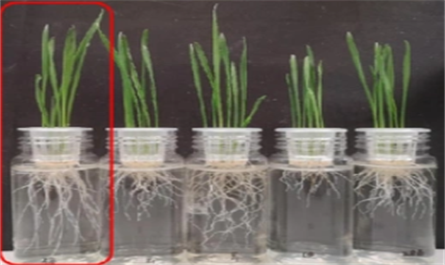Analysis, research and market of plant growth regulator natural brassinolide
The application of plant growth regulators is one of the five new technologies in agriculture. It has the characteristics of low investment, quick effect, dosage as low as ppm (parts per million), significant effect, and extremely high input-output ratio. With the development of agricultural production technology, the role of plant growth regulators is becoming more and more important. On the one hand, it can further increase crop yields. On the other hand, regulators can improve the plant's own immunity, play a health-care role, and reduce the amount of pesticides and the damage to crops caused by bad climate. The research on plant growth regulators and their application in production is one of the major advances in modern plant physiology and agricultural science. Agricultural scientists from all over the world attach great importance to this field. The application of plant growth regulators has become an important symbol of the level of development of agricultural science and technology.

1. Frequent global extreme weather affects agricultural production, and stress-resistant plant growth regulators play an increasingly important role
Agriculture is the foundation of the national economy, and climate is an important determinant affecting agricultural production. Meteorological disasters caused by climate change occur frequently, and the instability of agricultural production increases, which will have a profound impact on agricultural production conditions, agricultural natural resources, and agricultural natural disasters. Plant growth regulators can regulate crops themselves and improve their resistance potential. The technical demand of crops for plant regulation products (plant growth regulators) is becoming more and more important, and the market demand for crop stress-resistant inputs is increasing rapidly.
2. Adjustment of agricultural industrial structure, the value of plant growth regulators in stress resistance is increasing
The development trend of international economic integration urgently requires us to adjust the agricultural structure, intensive and efficient, mechanized, information-based, unmanned, off-season crop cultivation, fruit variety breeding technology, facility agriculture such as greenhouse vegetables, etc., the demand for precise regulation of crops is getting higher and higher, and the normal growth, yield and quality of crops are increasingly inseparable from the application of plant growth regulators.
3. Brassinolide sterols - the sixth largest category of plant growth regulators with the most stress resistance
In response to the food security, quality safety and quality safety issues brought about by abiotic stresses such as low temperature, drought and high temperature in the world, brassinolide, as a safe and efficient plant growth regulator, has the effect of significantly enhancing crop stress resistance, increasing crop yield and improving the quality of agricultural products. Its application value in agricultural production is becoming more and more significant.
Since the study of auxin in the 1930s, plant growth regulators have developed rapidly, and then gibberellins (GA), abscisic acid (ABA), cytokinins (CTK), ethylene (ETH) and brassinosteroids (BRs) have been discovered. Among the many types of plant growth regulators, brassinosteroids have become a hot topic among scientists since their discovery. Brassinosteroids are a type of plant hormone that plays multiple roles in plant growth and development. They were first extracted from rapeseed pollen of the genus Brassinosteroids by J.W.Mitchell and other scientists from the U.S. Department of Agriculture in 1970. It was not until 1998 that brassinosteroids were officially recognized as the sixth plant hormone at the 16th Annual Meeting of the International Society of Plant Growth Substances.
4. Research progress on the function and mechanism of action of brassinosteroids
4.1 Structural characteristics of brassinosteroids
BRs are a class of plant sterol hormones, and their basic structure is a steroid nucleus composed of four rings ABCD, a keto group at C6 on the B ring, and an alkyl side chain at C17 on the D ring. The hydroxylation level and spatial structure of the A ring and the alkyl side chain directly affect the affinity of BRs with its receptor complex, thereby affecting the biological activity of BRs. Natural brassinolide is the most active and thoroughly studied brassinosteroid known so far. Later, people used its molecular structure as a blueprint to artificially synthesize a variety of Brs analogs such as 24-epibrassinolide, 28-homobrassinolide, 28-epibrassinolide, mixed epibrassinolide, and propionylbrassinolide.

4.2 Study on the physiological function and mechanism of action of brassinosteroids
BRs are widely present in various plants. Dozens of brassinosteroids with different structures have been found in lower algae, ferns, gymnosperms and angiosperms, indicating that the signaling pathway of BRs originated in the early evolution of plants and is relatively conservative in plants. BRs are mainly concentrated in reproductive organs, immature seeds and tender tissues in plants, regulating reproductive development, seed maturation, promoting stem elongation and root morphology, and playing an active role in plant resistance to stress.
5. Industrialization of natural brassinosteroids
It has been reported that the production process of "brassinosteroids" is divided into two completely different process routes: natural extraction and artificial synthesis. According to the data, China's research on natural brassinosteroid extraction technology began in the early 1980s, initially using natural brassinosteroid active ingredients extracted from beeswax. The research on synthetic "brassinolide" analogs began in 1982. Countries around the world are committed to the synthetic synthesis of brassinolide, making low-cost, large-scale, industrialized production of brassinolide substances a reality. At present, synthetic brassinolides that have been registered as pesticides in China include: 24-epibrassinolide, 28-homobrassinolide, 22, 23, 24-triepibrassinolide, 28-epiohomobrassinolide and propionylbrassinolide. Among them, the first four brassinolides are all based on natural Brassinolide as samples. According to their structural differences, their biological activities are also different. Propionylbrassinolide is a propionylated brassinolide, which itself does not have biological activity, but needs to be absorbed and metabolized in the body to play a role.

6. Research on natural brassinolide technology
Among all brassinolides, natural brassinolide 14-hydroxybrassinolide sterol has obtained the dominant crystal form of natural brassinolide sterol that can significantly regulate plant growth by comprehensively investigating chemical factors that can cause polymorphism, including solvent type, quantity, proportion, saturation, etc. and physical factors, including temperature, pressure, speed, humidity, etc. Compared with other brassinolide sterol compounds, its biological activity is improved by more than 50% in rapid effect, effectively solving the problems of "slow effect", "unstable safety" and "unstable activity" of other brassinolide compounds circulating on the market. Obvious effects can be seen in 3 to 5 days. At the same time, it has a very important stabilizing effect and functional improvement in increasing crop yields, resisting adverse growth, improving quality and improving the taste of agricultural products, and increasing photosynthesis.
7. Future and Prospects
As a broad-spectrum, highly active plant growth regulator, 14-hydroxybrassinolide sterol has become a highly well-known biological pesticide variety in the plant growth regulator market due to its unique physiological activity, wide range of applications, ultra-low dosage, extremely high safety, and outstanding effects of increasing production and income. At the same time, with the upgrading of consumer demand for agricultural product quality, the advancement and implementation of global agricultural green development, food security and biosecurity development strategies, natural brassinolide sterols will surely play an increasingly important role in promoting green agricultural development, high-quality development and enhancing agricultural value.

1. Frequent global extreme weather affects agricultural production, and stress-resistant plant growth regulators play an increasingly important role
Agriculture is the foundation of the national economy, and climate is an important determinant affecting agricultural production. Meteorological disasters caused by climate change occur frequently, and the instability of agricultural production increases, which will have a profound impact on agricultural production conditions, agricultural natural resources, and agricultural natural disasters. Plant growth regulators can regulate crops themselves and improve their resistance potential. The technical demand of crops for plant regulation products (plant growth regulators) is becoming more and more important, and the market demand for crop stress-resistant inputs is increasing rapidly.
2. Adjustment of agricultural industrial structure, the value of plant growth regulators in stress resistance is increasing
The development trend of international economic integration urgently requires us to adjust the agricultural structure, intensive and efficient, mechanized, information-based, unmanned, off-season crop cultivation, fruit variety breeding technology, facility agriculture such as greenhouse vegetables, etc., the demand for precise regulation of crops is getting higher and higher, and the normal growth, yield and quality of crops are increasingly inseparable from the application of plant growth regulators.
3. Brassinolide sterols - the sixth largest category of plant growth regulators with the most stress resistance
In response to the food security, quality safety and quality safety issues brought about by abiotic stresses such as low temperature, drought and high temperature in the world, brassinolide, as a safe and efficient plant growth regulator, has the effect of significantly enhancing crop stress resistance, increasing crop yield and improving the quality of agricultural products. Its application value in agricultural production is becoming more and more significant.
Since the study of auxin in the 1930s, plant growth regulators have developed rapidly, and then gibberellins (GA), abscisic acid (ABA), cytokinins (CTK), ethylene (ETH) and brassinosteroids (BRs) have been discovered. Among the many types of plant growth regulators, brassinosteroids have become a hot topic among scientists since their discovery. Brassinosteroids are a type of plant hormone that plays multiple roles in plant growth and development. They were first extracted from rapeseed pollen of the genus Brassinosteroids by J.W.Mitchell and other scientists from the U.S. Department of Agriculture in 1970. It was not until 1998 that brassinosteroids were officially recognized as the sixth plant hormone at the 16th Annual Meeting of the International Society of Plant Growth Substances.
4. Research progress on the function and mechanism of action of brassinosteroids
4.1 Structural characteristics of brassinosteroids
BRs are a class of plant sterol hormones, and their basic structure is a steroid nucleus composed of four rings ABCD, a keto group at C6 on the B ring, and an alkyl side chain at C17 on the D ring. The hydroxylation level and spatial structure of the A ring and the alkyl side chain directly affect the affinity of BRs with its receptor complex, thereby affecting the biological activity of BRs. Natural brassinolide is the most active and thoroughly studied brassinosteroid known so far. Later, people used its molecular structure as a blueprint to artificially synthesize a variety of Brs analogs such as 24-epibrassinolide, 28-homobrassinolide, 28-epibrassinolide, mixed epibrassinolide, and propionylbrassinolide.

4.2 Study on the physiological function and mechanism of action of brassinosteroids
BRs are widely present in various plants. Dozens of brassinosteroids with different structures have been found in lower algae, ferns, gymnosperms and angiosperms, indicating that the signaling pathway of BRs originated in the early evolution of plants and is relatively conservative in plants. BRs are mainly concentrated in reproductive organs, immature seeds and tender tissues in plants, regulating reproductive development, seed maturation, promoting stem elongation and root morphology, and playing an active role in plant resistance to stress.
5. Industrialization of natural brassinosteroids
It has been reported that the production process of "brassinosteroids" is divided into two completely different process routes: natural extraction and artificial synthesis. According to the data, China's research on natural brassinosteroid extraction technology began in the early 1980s, initially using natural brassinosteroid active ingredients extracted from beeswax. The research on synthetic "brassinolide" analogs began in 1982. Countries around the world are committed to the synthetic synthesis of brassinolide, making low-cost, large-scale, industrialized production of brassinolide substances a reality. At present, synthetic brassinolides that have been registered as pesticides in China include: 24-epibrassinolide, 28-homobrassinolide, 22, 23, 24-triepibrassinolide, 28-epiohomobrassinolide and propionylbrassinolide. Among them, the first four brassinolides are all based on natural Brassinolide as samples. According to their structural differences, their biological activities are also different. Propionylbrassinolide is a propionylated brassinolide, which itself does not have biological activity, but needs to be absorbed and metabolized in the body to play a role.

6. Research on natural brassinolide technology
Among all brassinolides, natural brassinolide 14-hydroxybrassinolide sterol has obtained the dominant crystal form of natural brassinolide sterol that can significantly regulate plant growth by comprehensively investigating chemical factors that can cause polymorphism, including solvent type, quantity, proportion, saturation, etc. and physical factors, including temperature, pressure, speed, humidity, etc. Compared with other brassinolide sterol compounds, its biological activity is improved by more than 50% in rapid effect, effectively solving the problems of "slow effect", "unstable safety" and "unstable activity" of other brassinolide compounds circulating on the market. Obvious effects can be seen in 3 to 5 days. At the same time, it has a very important stabilizing effect and functional improvement in increasing crop yields, resisting adverse growth, improving quality and improving the taste of agricultural products, and increasing photosynthesis.

7. Future and Prospects
As a broad-spectrum, highly active plant growth regulator, 14-hydroxybrassinolide sterol has become a highly well-known biological pesticide variety in the plant growth regulator market due to its unique physiological activity, wide range of applications, ultra-low dosage, extremely high safety, and outstanding effects of increasing production and income. At the same time, with the upgrading of consumer demand for agricultural product quality, the advancement and implementation of global agricultural green development, food security and biosecurity development strategies, natural brassinolide sterols will surely play an increasingly important role in promoting green agricultural development, high-quality development and enhancing agricultural value.



